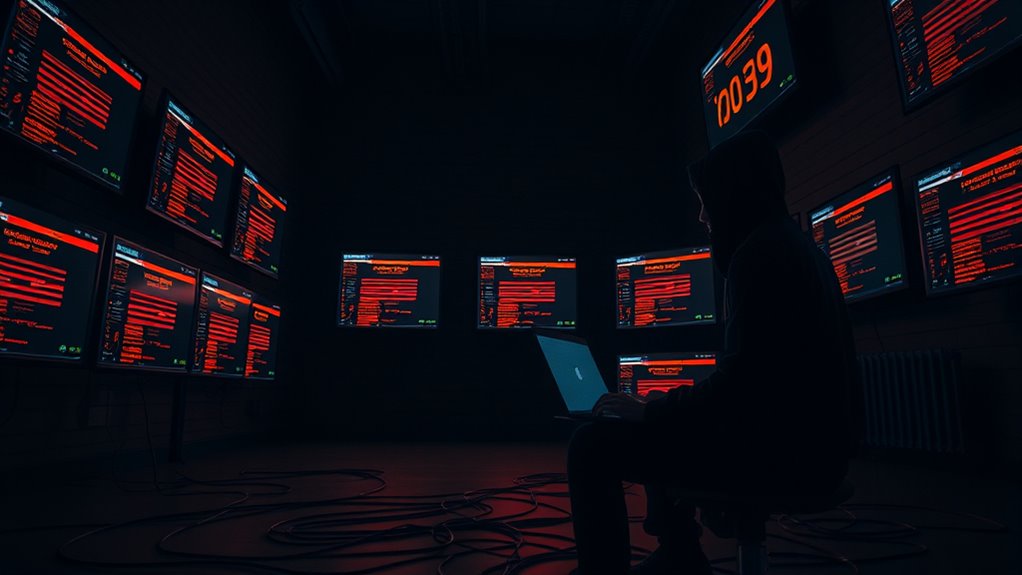Cybersecurity threats are escalating, and you need to be prepared. In 2023 alone, ransomware attacks surged by 67%, and the average cost of data breaches is climbing towards $4.88 million. Generative AI is fueling these attacks, with a staggering 4151% increase in AI-driven phishing. Supply chain vulnerabilities have also skyrocketed. Understanding these risks is crucial for your organization's survival. There's much more to uncover about what you can do to protect yourself in this evolving landscape.
Key Takeaways
- Ransomware attacks surged by 67% in 2023, highlighting the need for robust incident response strategies to mitigate downtime costs.
- The global cost of cybercrime is projected to reach $10.5 trillion annually by 2025, emphasizing the financial urgency for improved cybersecurity measures.
- AI-driven threats have increased dramatically, with phishing attacks rising by 4151%, necessitating enhanced training for employees on recognizing such scams.
- Supply chain attacks have surged by 431% since 2021, urging organizations to evaluate third-party cybersecurity risks in partnerships by 2025.
- Cyber insurance premiums are expected to double from $14 billion in 2023 to $29 billion by 2027, indicating the growing financial impact of cyber threats.

Cybersecurity Shockers
In a world where technology evolves rapidly, the cybersecurity landscape is becoming increasingly alarming. Recent cyber attacks have demonstrated just how vulnerable we are. For instance, a decentralized money lender lost a staggering $9.5 million in a crypto heist in February 2025, while Bybit's ETH cold wallet was hacked for a record $1.46 billion.
These incidents are just the tip of the iceberg, as GrubHub faced a massive data breach affecting customer, driver, and merchant information, and DISA reported a breach impacting 3.3 million individuals. Even established firms like Insight Partners fell victim to social engineering attacks. It's clear that no one is safe.
Ransomware is another growing menace. In 2023, attacks surged by 67%, costing businesses about $53,000 per hour in downtime. By 2024, 59% of organizations reported being affected by ransomware, and cryptocurrency heists linked to ransomware rose by 2%. Black Basta ransomware has emerged as a notable threat, causing significant financial impacts on various organizations.
Ransomware attacks surged 67% in 2023, costing businesses $53,000 per hour in downtime, with 59% affected by 2024.
LockBit and similar families continue to pose serious threats, making it essential for you to stay vigilant and proactive in your cybersecurity measures.
The financial implications of cybercrime are staggering. It's projected that global cybercrime costs will reach $10.5 trillion annually by 2025, increasing to $15.63 trillion by 2029. Data breaches are expensive too, with the average cost soaring to $4.88 million in 2024—an increase of 10% from the previous year.
As a result, cyber insurance premiums are expected to grow significantly, from $14 billion in 2023 to $29 billion by 2027.
Artificial intelligence is adding another layer of complexity to the cybersecurity landscape. A staggering 85% of cybersecurity professionals link the rise in attacks to generative AI. In fact, AI-driven phishing attacks have skyrocketed by 4151% since the release of ChatGPT.
While 24% of organizations believe AI can improve incident response efficiency, 46% of security experts worry that AI integration heightens vulnerability.
Supply chain risks also demand your attention. Attacks in this area surged by 431% between 2021 and 2023, and by 2031, they could cost businesses an estimated $130 billion.
As you consider partnerships with third parties, remember that 60% of organizations will factor in cybersecurity risks by the end of 2025.
With the healthcare sector facing significant threats and the energy sector accounting for 11% of cyber incidents in 2023, it's crucial to remain informed and proactive. Keeping your digital assets secure is more important now than ever.
Frequently Asked Questions
What Are the Most Common Types of Cyberattacks Today?
Today, the most common types of cyberattacks include phishing, ransomware, and DDoS attacks.
You'll often find phishing scams targeting your personal information through deceptive emails.
Ransomware can lock your files until you pay a ransom, causing significant disruption.
DDoS attacks overwhelm websites with traffic, leading to downtime.
Being aware of these threats helps you take necessary precautions to protect your data and maintain your online security.
Stay vigilant and informed!
How Can I Improve My Personal Cybersecurity at Home?
Improving your personal cybersecurity at home is a piece of cake—if you enjoy living dangerously!
Start by regularly updating your software and ditching unnecessary apps. Strengthen your passwords and enable two-factor authentication; it's like adding a moat around your digital castle.
Install a firewall and encrypt your Wi-Fi. Don't forget to back up your data regularly.
Finally, stay alert for phishing attempts—because who doesn't love a good digital surprise?
What Should I Do if My Data Is Compromised?
If your data's compromised, act quickly.
First, isolate the affected systems to stop further access. Assess the breach's scope and gather necessary information. Notify relevant parties and authorities as required.
Next, implement measures to prevent future incidents, like updating your security protocols. Document all actions taken for future reference.
Finally, consider consulting legal experts to ensure compliance with applicable laws and offer support, like credit monitoring, to those affected.
Are Free Cybersecurity Tools Effective for Protection?
Free cybersecurity tools can be a lifesaver, but they're not a magic shield.
You'll find they're effective for basic protection, offering budget-friendly options for organizations. However, you should be cautious of higher false positives and limited integration with other tools.
To maximize their effectiveness, combine them with training and proactive measures. Regular updates and community support can enhance your security, but remember, they're just one part of a comprehensive cybersecurity strategy.
How Often Should I Change My Passwords for Security?
You should change your passwords when you suspect they've been compromised or at least every 365 days.
Frequent changes can lead to weaker passwords, as you might just tweak existing ones. Instead, focus on creating strong, long passwords and use a password manager to handle them.
Implementing multifactor authentication also adds an extra layer of security, making it harder for hackers to access your accounts, even if they guess your password.
Conclusion
As you navigate the digital landscape, think of your cybersecurity measures as a sturdy fortress. Each password is a brick, each update a stronghold, and each awareness of threats is a watchtower guarding against potential breaches. By fortifying your defenses, you're not just surviving; you're thriving in a world where the unexpected lurks around every corner. Remember, a vigilant mind is your most powerful weapon. Stay alert, stay prepared, and let your fortress stand tall against the tides of cyber threats.









